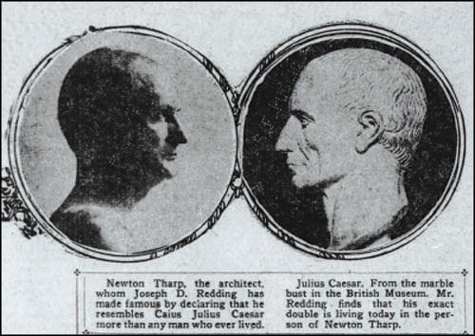Newton J. Tharp in the News
The San Francisco Call Newspaper
February 26, 1909
Newton J. Tharp is Caesar's Double: Prominent Local Architect Exhibited in Toga by J.D. Redding, Lecturer
Berkley, Feb. 25 -- Joseph D. Redding, the San Francisco attorney, Bohemian club man and lecturer, surpassed Professor Ferrero at scattering the mists of antiquity tonight by revealing Julius Caesar's double to an audience at California Hall. Newton J. Tharp, a San Francisco architect, well known on the coast, was the double.
The expose was inserted into a lecture on "The Battlefield of Alesia" which, according to Redding, Ferrero and others, was the particular old testing ground on which the great first consul won a mighty victory over the Guals of Ulterior Gallia. Adhering to the Ferrerian methods of depicting the dead past, the lecturer illustrated his subject with stereopticon slides.
When Caesar, dead and turned to clay, had been show up as a man, the lecturer revealed the modern counterpart. He displayed the architect in toga, and declared that Tharp resembled Caesar more than any man who ever lived. Among those who attended the lecture were Mayor Edward Robeson Taylor of San Francisco, District Attorney W.H. Largon and Benjamin Ide Wheeler, president of the University of California.
The San Francisco Call Newspaper
February 27, 1909
Tharp's Caesar Face Proves Preservation of Aryan Type: In Startling Resemblance of Two Profiles Twenty Centuries are Spanned

Newton J. Tharp, city architect, shown by Joseph D. Redding, a lawyer and historical scholar, to be a double of Julius Caesar, was yesterday pointed out by Redding as a shining illustration of the manner in which the Aryan race has maintained its type through 2,000 years of history. A photograph of Tharp gowned in the obsolete purple placed alongside a profile of Julius Caesar shows a startling resemblance. This fact, historians argue, indicates that notwithstanding 2,000 years of trouble, war, political campaigns and beauty doctors, little change has been wrought in the Aryan face. In Tharp the years roll away. Modernism is kicked into the swamps and the world is back again to the days when J. Caesar spanked little Ptolemy and grunted cynicisms into the ear of Cleopatra. Tharp is the link between the old and the new, the connecting rod between the has been and the now is.
"In my studies and travels," said, Redding last night, "I was forcibly impressed with the likeness existing between Tharp, whom I know very well, and the portraits of Julius Caesar, and on my return to San Francisco asked him to pose for a photograph. The pose arranged by Arnold Genthe and myself brought out the resemblance still more. This fact to me is interesting only in so far as it shows the manner in which the Aryan race has maintained its type. It shows that men of the past resembled to a large extent those of the present day."
Tharp had no explanations to offer. "Several persons have told me I was like Julius Caesar," he said, with a modest grin, "but as far as I know myself I fail to see the similarity."
That there is a decided facial resemblance between the two men there is no gainsaying. When delivering his lecture at Berkeley Thursday night Redding flashed various photographs of busts of Caesar taken by him in the British and Berlin museums and on Capitoline Hill in Rome, and then told his audience he would show them a photograph of Tharp, illustrating the resemblance between the old and the new. When Tharp's picture was thrown on the screen the audience thought some mistake had been made in the slides, believing it to be another portrait of Caesar, and it was necessary for the lecturer to explain the situation.
Tharp comes of English stock, and his friends in discussing as to where he got his face have trudged through the pages of history to the time when Caesar kicked over the Druid temples and taught the woad painted Britons the danger of trifling with a buzz saw. According to this theory one of Tharp's remote ancestors was a relative of Caesar, and when the latter went back to Rome to play politics he remained behind and settled in the conquered land. From him, after 2,000 years, came Newton J. Tharp, city architect of San Francisco, perfect prototype of Julius Caesar, a living monument to the assertion that history repeats itself.
Caesar Reincarnated
Another theory is that Tharp may be Julius Caesar reincarnated. If so, Tharp has yet to learn the fact. Rider Haggard and Rudyard Kipling have drawn interesting and fanciful studies of men who have peered across the chasm separating the eternities, but Tharp has none of the characteristics which made life so much of a burden for those interesting heroes lugged forth before the public in the demands of big royalties. He does not sometimes have strange yearnings to make Mr. Pharnaces hit the high places. Never to him has been wafted the scent of the snows of the Pyrenees. No Pompey's chopped head appears in his dreams. When he sees the fire department going down the street his mind does not involuntarily turn to thoughts of Alexandria and Vercingetorix troubles him as little as does his appendix. As a reincarnated Caesar he is not a drawing card. He does not catch himself sighing at the thought of Cleopatra whenever the beauty chorus in the musical extravaganza trips on the stage.